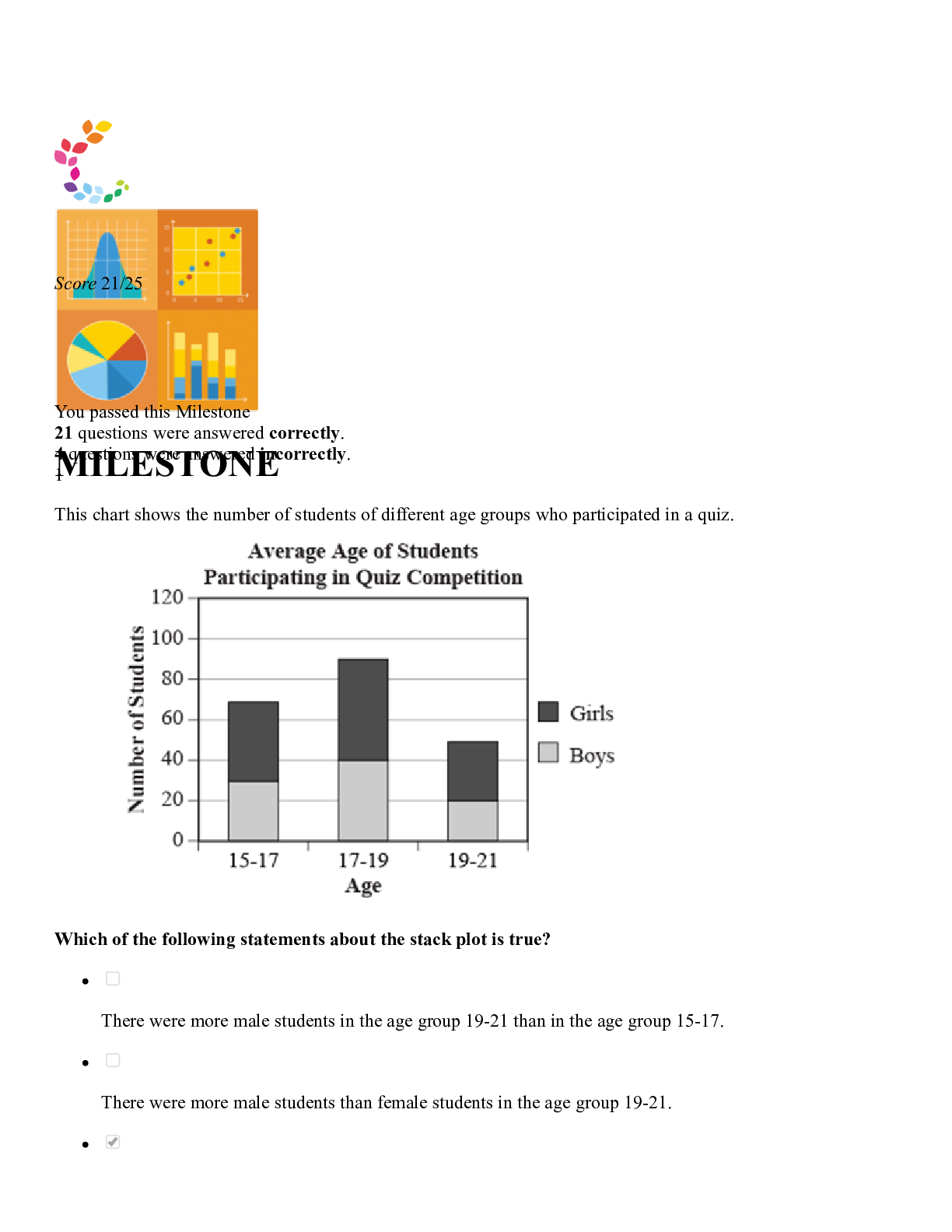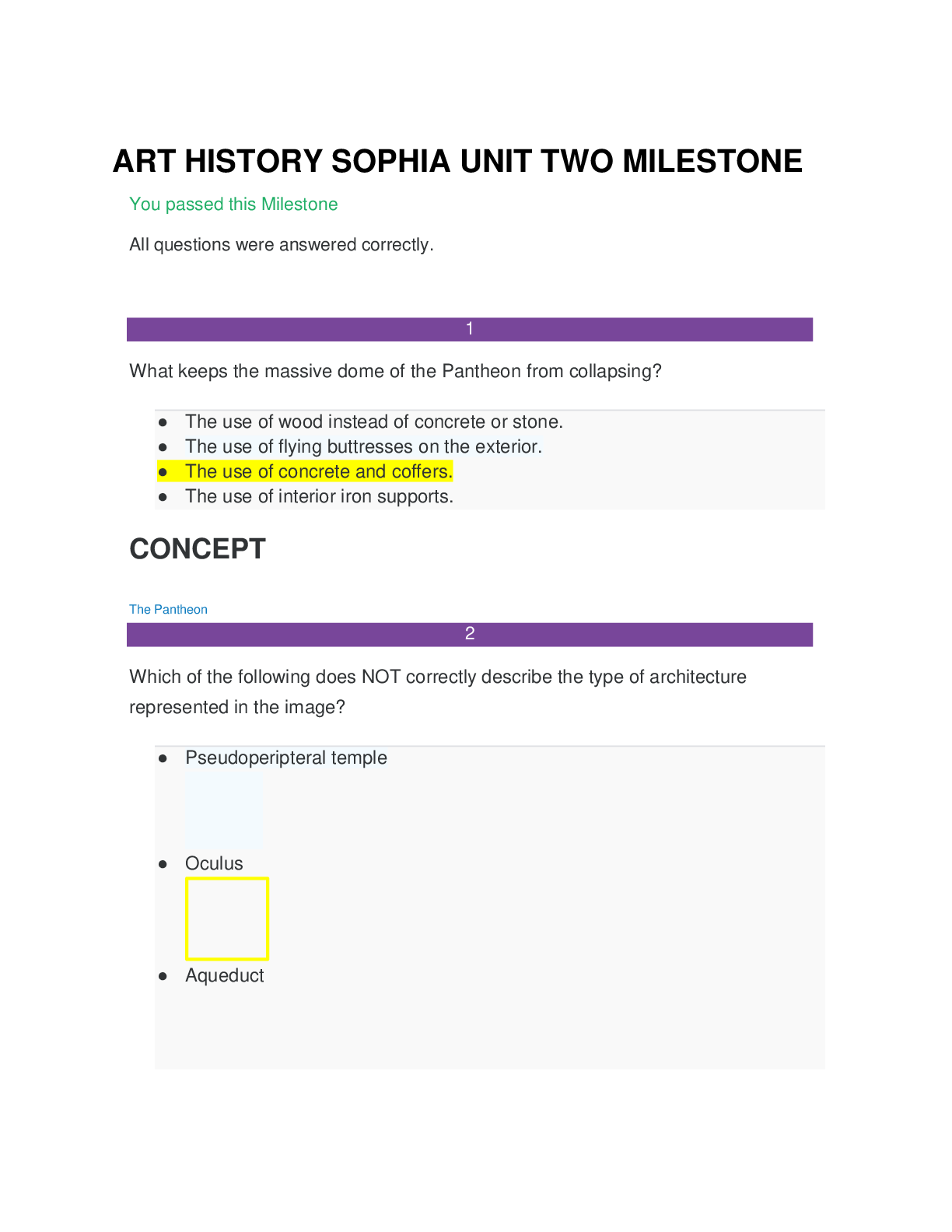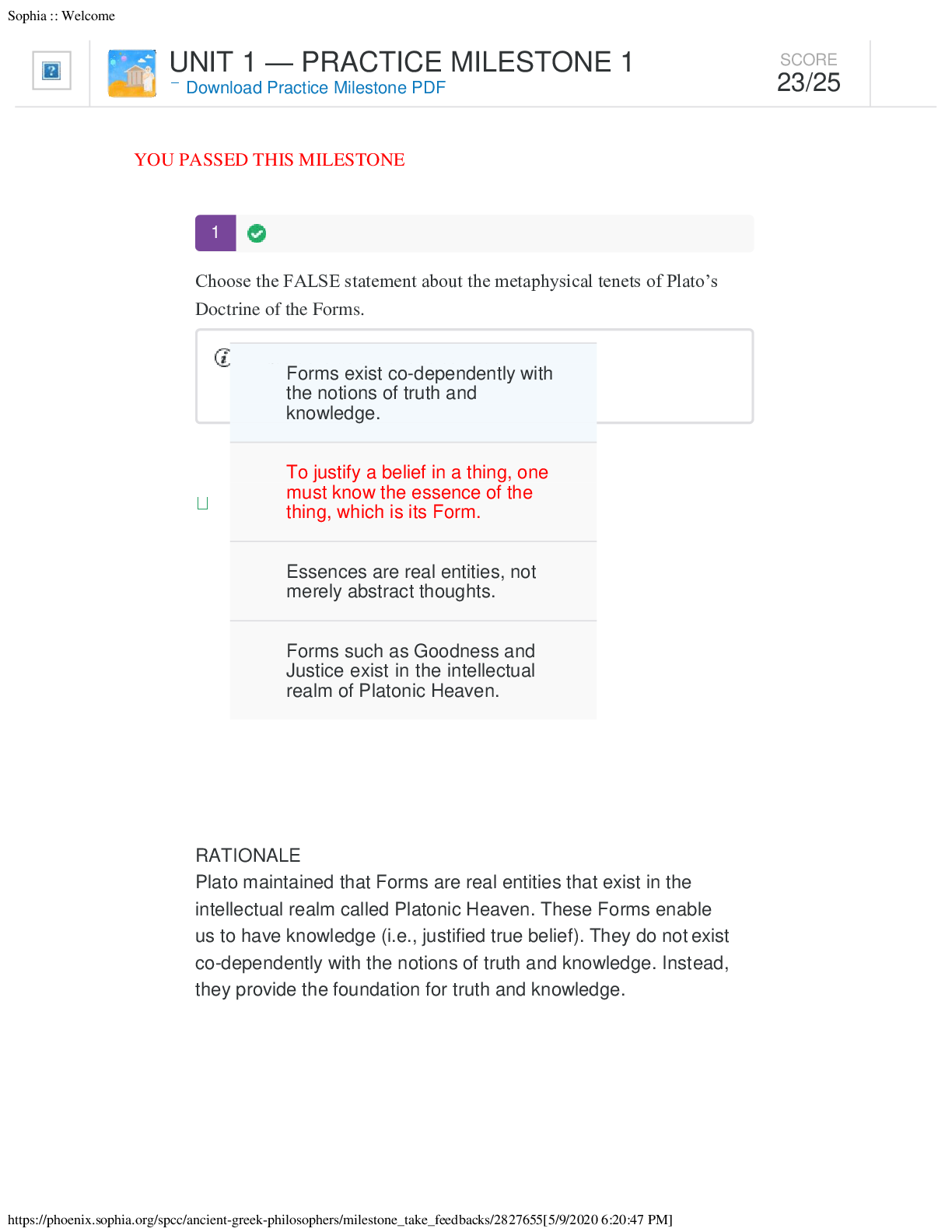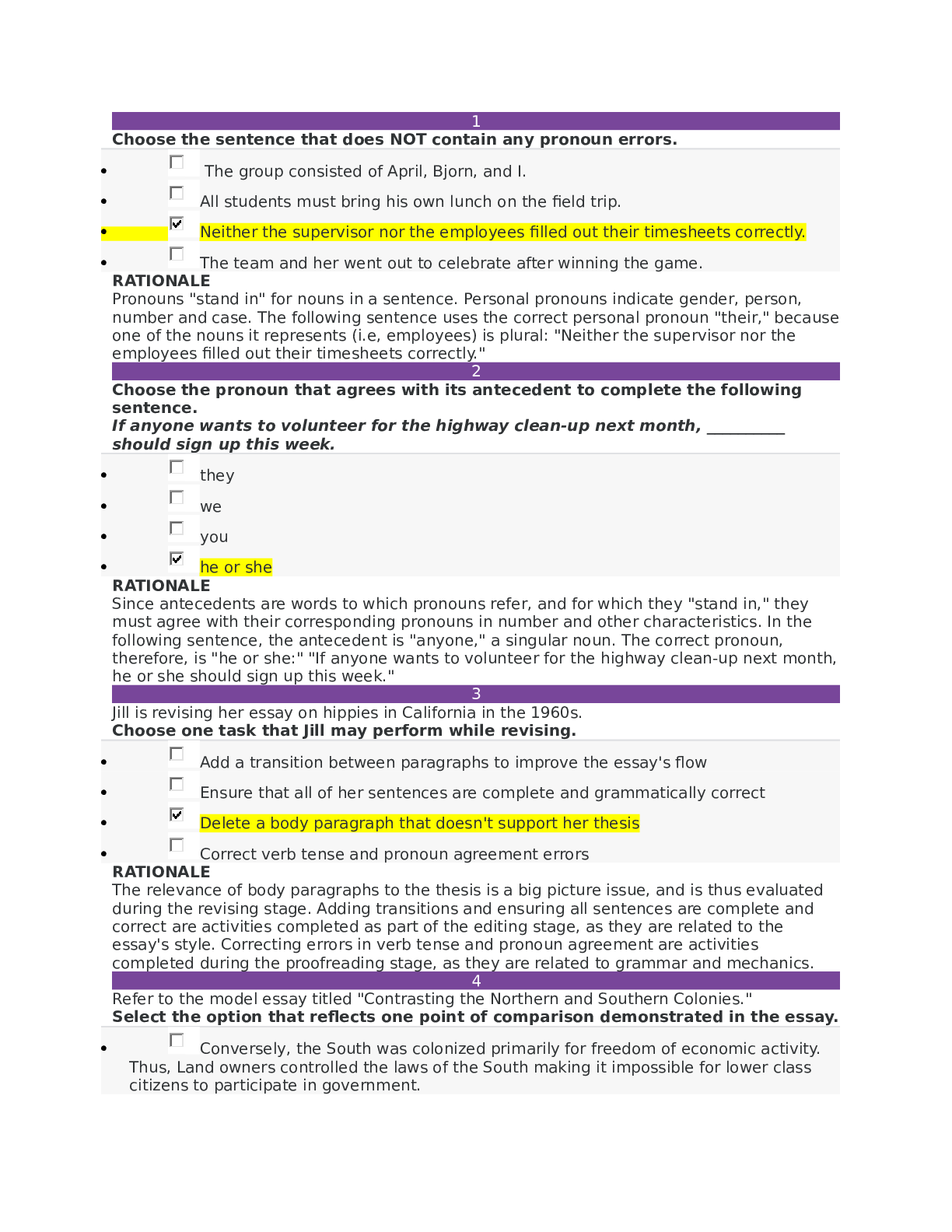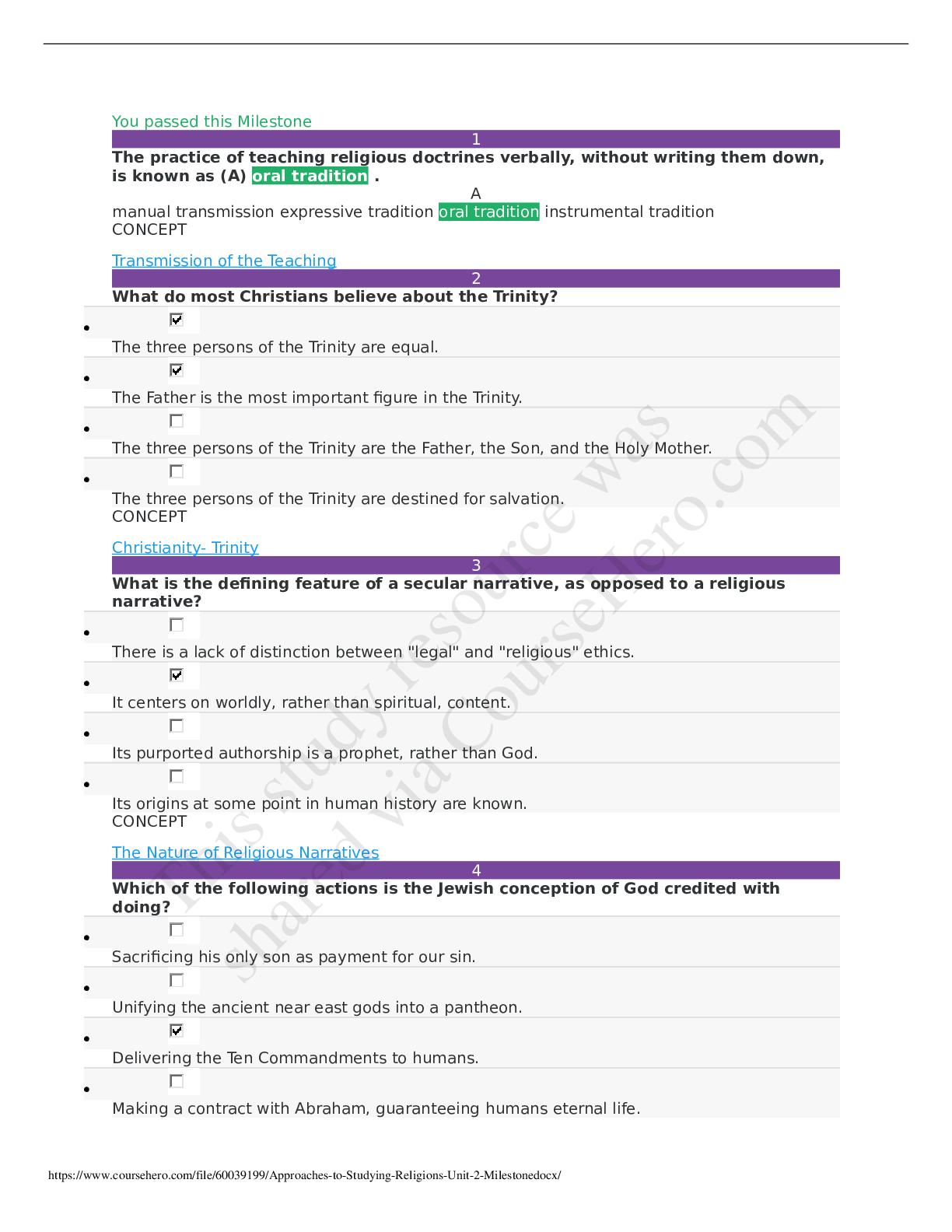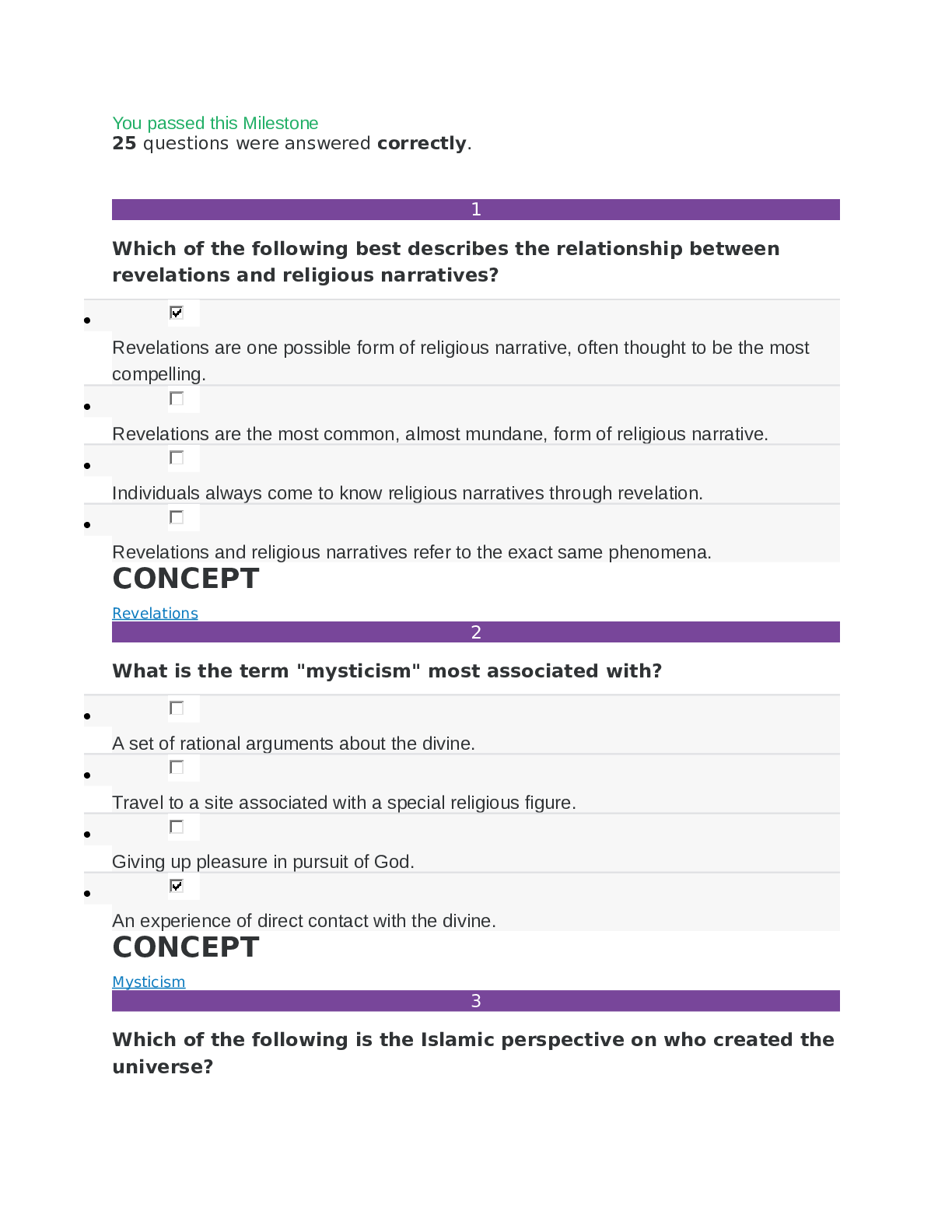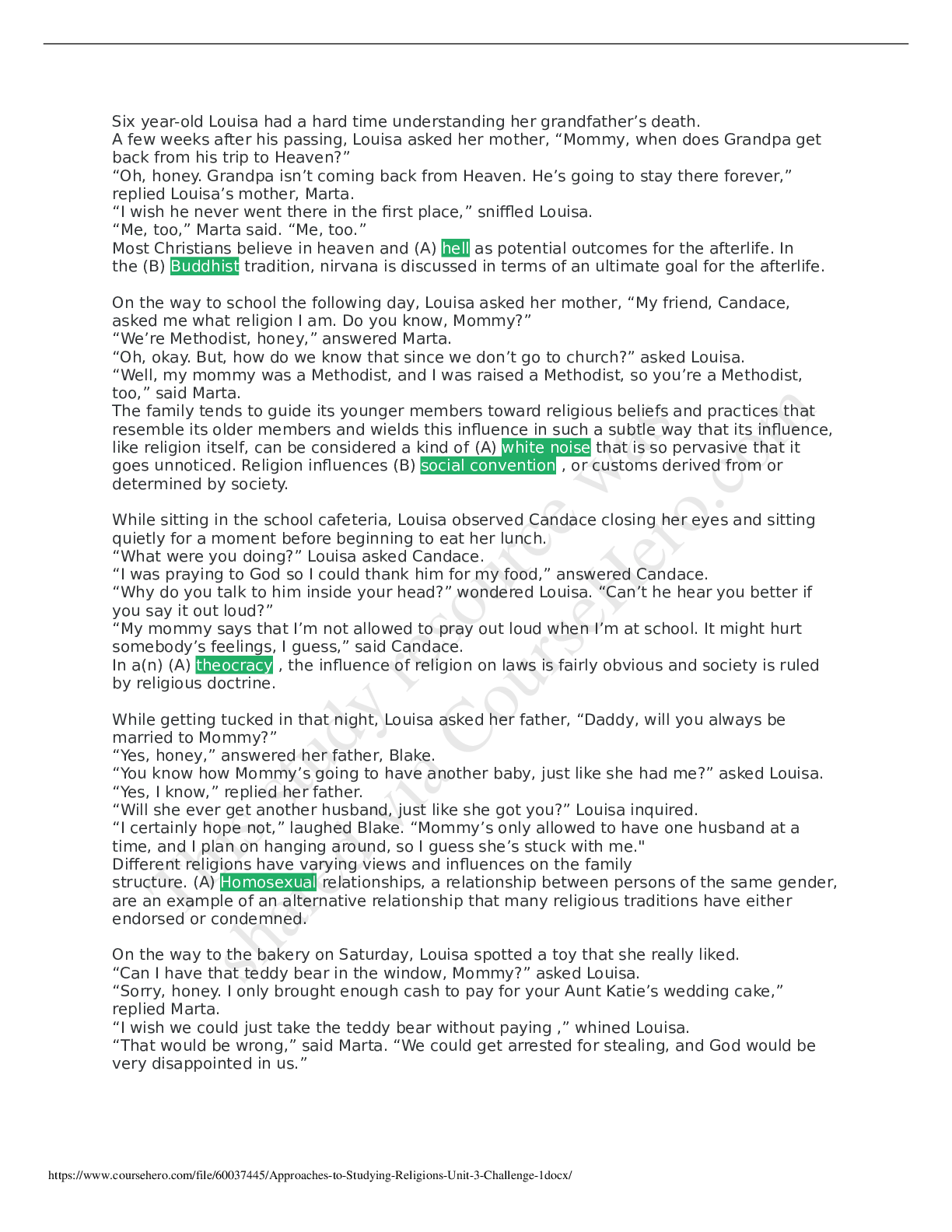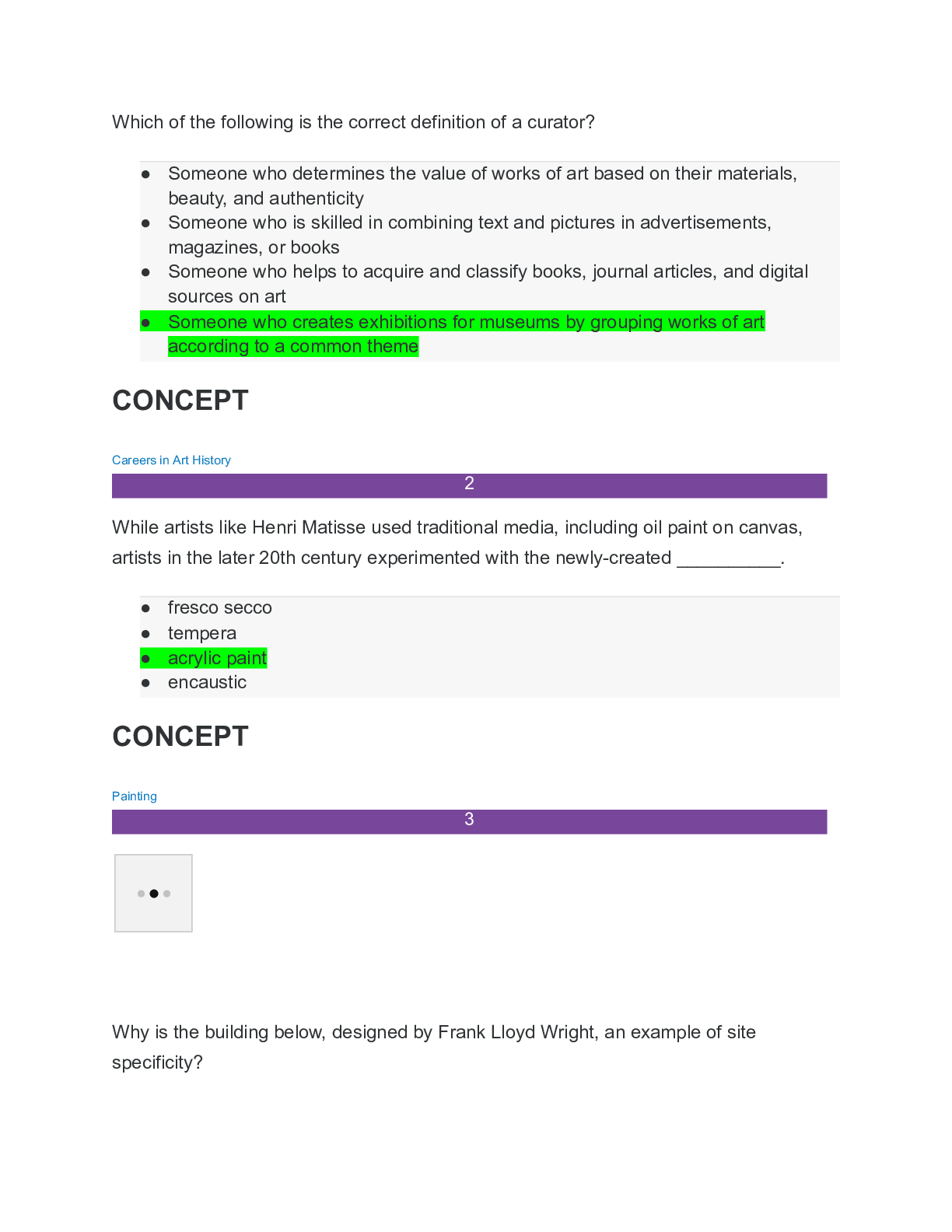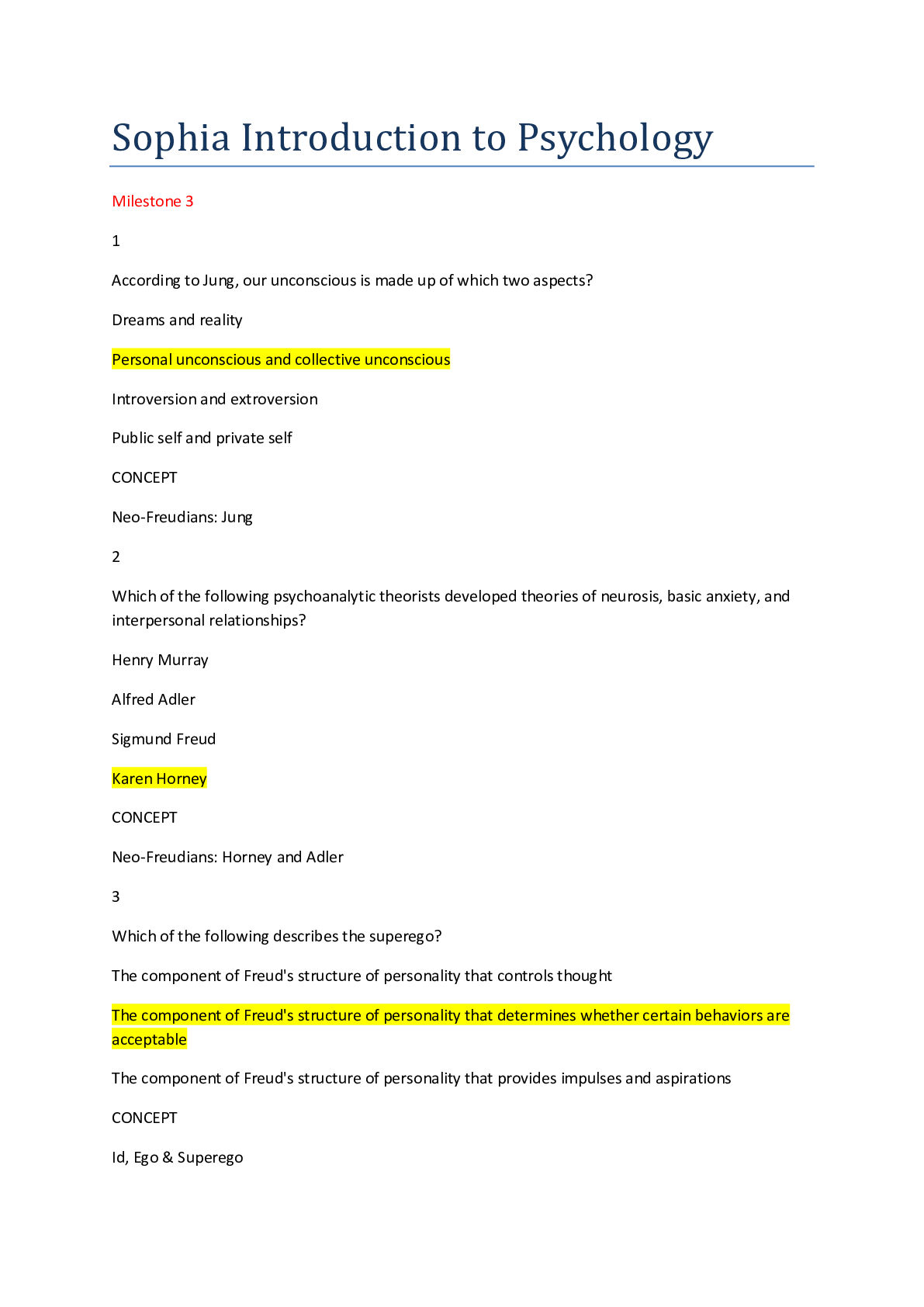Religious Studies > SOPHIA Milestone > Strayer University - RELIGION REL 212Approaches to Studying Religions Unit 2 Challenge 3. Correct 10 (All)
Strayer University - RELIGION REL 212Approaches to Studying Religions Unit 2 Challenge 3. Correct 100%.
Document Content and Description Below
As five-year-old Lila's mother, Katie, tucked her into bed, Lila asked her, “Where did I come from?” “Well, you came from your father and me,” Katie answered. “But where did you come from?... ” Lila asked. Katie kissed Lila on her forehead. “From my father and mother, who came from their fathers and mothers. It goes back like that all the way to the beginning, until you get to Adam and Eve.” (A) creation stories attempt to answer ultimate questions, such as “where did I come from?” as well as questions of a more general nature pertaining to the emergence of civilization and technology. The next morning, Lila attended church with her parents. At Sunday School, she learned the parable of the talents. While walking to the car, Katie asked her daughter what she learned. “I learned to use my gifts instead of hiding them away,” answered Lila. “Jesus wants me to use the talents that he gave me.” “That’s right,” said Lila’s father, Greg. Katie and Greg smiled as they put Lila in the back seat. A story that typically aims to make a single teaching point, rather than make an extended comparison, is called a(n) (A) parable , whereas an analogy or illustration that draws comparisons between two apparently dissimilar situations at many points is known as a(n) (B) allegory . As the family ate lunch, Lila asked her parents why God doesn’t answer her when she prays. “He does answer you, Lila. You just can’t hear him,” answered Greg. “Can you hear him?” Lila asked her father. “No, I can’t. Some people have heard him. You’ll probably learn about some of them at Sunday School,” Greg replied. Categorize the statements about revelations as true or false. = Correct Answer = Incorrect Answer True False Revelations do not usually involve the use of a human intermediary to deliver God's message Revelations claim to be accounts of direct communication from God to humankind In revelations, God is considered both the “author” and, in effect, the writer as well Later that month, Katie’s mother passed away. At her grandmother’s funeral, Lila turned to Katie and said, “Don’t worry, Mommy. I don’t think that Grandma is all dead. The thing that made her Grandma is still alive.” Stunned at her precocious daughter, Katie asked, “Why do you think that, Lila?” “Because she was always Grandma, even before I was born, so she was probably Grandma before she was born. She’s been Grandma for so long, God will probably just let her keep on being Grandma, even after her body goes in the ground,” responded Lila. Katie hugged her daughter and said, “How’d you get to be so smart, Lila?” “I was just born that way, I guess,” answered Lila with a smile. https://www.coursehero.com/file/60037474/Approaches-to-Studying-Religions-Unit-2-Challenge-3docx/ This study resource was shared via CourseHero.comThe word animism comes from the (A) Latin word, anima, meaning soul, or life ʺ ʺ ʺ force.ʺ (B) Pantheism generally holds that the created, material world is infused with the presence of an immanent, all-present God. As Lila dressed for ballet class, she asked her mother, “Is God an only child like me?” Katie thought for a moment and responded, “I guess so. I don’t think that he has any brothers or sisters, if that’s what you mean.” “So, there’s only one of him?” asked Lila, trying to understand. “Well, that’s what I believe. Some people believe that there are many gods,” Katie answered. Lila thought about this as she searched for her ballet slippers. Which two of the following statements are true of monotheism? Taoism is is monotheistic religion. “Monotheism” means “one god.” All monotheistic religions refer to God by the same names. Monotheism is the belief that one god dominates all others. Monotheism is inconsistent with the doctrine of the Trinity. Judaism agrees more with Islam than with Christianity on the subject of monotheism. Before bed, Katie overheard Lila saying her nighttime prayers. “Hi, God. It’s me, Lila,” she began. “I hope that you remember me. I just wanted to say thank you for my mommy and daddy, and thank you for the grass and the climbing tree. And thank you for my dog and my friends and please let tomorrow be a good day. Amen.” When Lila finished with her prayer, Katie entered and said gently, “Your prayer was very sweet, Lila, but why do you tell God who you are every time? I’d bet that he remembers you by now.” “I just thought that there are so many little girls praying at the same time that he might get us confused,” Lila reasoned. “I think that God knows exactly who you are, just like he knows each of his children,” said Katie. (A) Deism is the belief in a non-personal god who ensures the proper functioning of the universe, but does not interact with people. One day after school, Lila came home in tears. “What’s wrong?” Greg asked his daughter. “My friend in class told me that God doesn’t care when I pray. She said he doesn’t even listen! She thinks that he just set up the world and makes sure that it is still working right!” sobbed Lila. “Well, that’s what some people believe,” said Greg. “I don’t happen to agree with them. Lots of people believe different things when it comes to God, Lila. You just have to have faith in what you believe. Rather than letting other opinions upset you, try to learn from people who see things differently.” Which of the following is the belief in a non-personal god, or divine overseer, who ensures the proper functioning of the universe but does not interact with human beings? https://www.coursehero.com/file/60037474/Approaches-to-Studying-Religions-Unit-2-Challenge-3docx/ This study resource was shared via CourseHero.com Polytheism Theism Deism Monotheism Animism Henotheism On Saturday morning, Lila watched a cartoon about a superhero named Captain Thunder. “Can God fly like Captain Thunder?” Lila asked her mother. “If he wanted to, I think he could. God is very powerful,” Katie answered. “Captain Thunder’s best friend, Red Laser, uses his eyes to burn holes in mountains! Does God have any friends who are as powerful as he is?” asked Lila. “Some people might think that there are many gods who are powerful,” replied Katie. “But remember when I told you that God is sort of an only child like you? Like I said then, I think that there’s only one of him. People of other religions may disagree with me.” Lila nodded and then turned her attention back to the television. (A) Henotheism is the belief that one god exists as primary, but that other deities may also exist who are worthy of worship. This belief is most notable in the religion of (B) Hinduism . “Mommy, does everyone believe in God?” asked Lila after cartoons. “No, Lila. Some people think that God doesn’t exist at all,” answered Katie. “Where do those people go to church?” the little girl wondered. Katie laughed. “I don’t think that they go to church anywhere, Lila, but I’ve never really thought about it.” (A) Agnosticism is the belief that the existence of god(s) has not been proven or can never be proven. When Greg came home from a golf outing, Lila greeted him and said, “Daddy! Did you know that there are some people who don’t believe in God at all, and that there are some people who believe that there are lots of gods?” “Yes, Lila, I did know that. The differences in religious beliefs are very interesting. Did you know that there are some people who simply believe that we couldn’t know if there is a god or not? Other religions believe some of the same things that we do, but don’t have a god at all,” said Greg. “That’s a lot to think about,” said little Lila. “It sure is,” Greg smiled. “It sure is.” Match the appropriate criteria to the categories shown. = Correct Answer = Incorrect Answer Form of non-theism Religious nontheism Religious theism https://www.coursehero.com/file/60037474/Approaches-to-Studying-Religions-Unit-2-Challenge-3docx/ This study resource was shared via CourseHero.comAtheism Christianity Buddhism https://www.coursehero.com/file/60037474/Approaches-to-Studying-Religions-Unit-2-Challenge-3docx/ This study resource was shared via CourseHero.com Powered by TCPDF (www.tcpdf.org) [Show More]
Last updated: 1 year ago
Preview 1 out of 4 pages

Reviews( 0 )
Document information
Connected school, study & course
About the document
Uploaded On
Mar 20, 2021
Number of pages
4
Written in
Additional information
This document has been written for:
Uploaded
Mar 20, 2021
Downloads
0
Views
95

